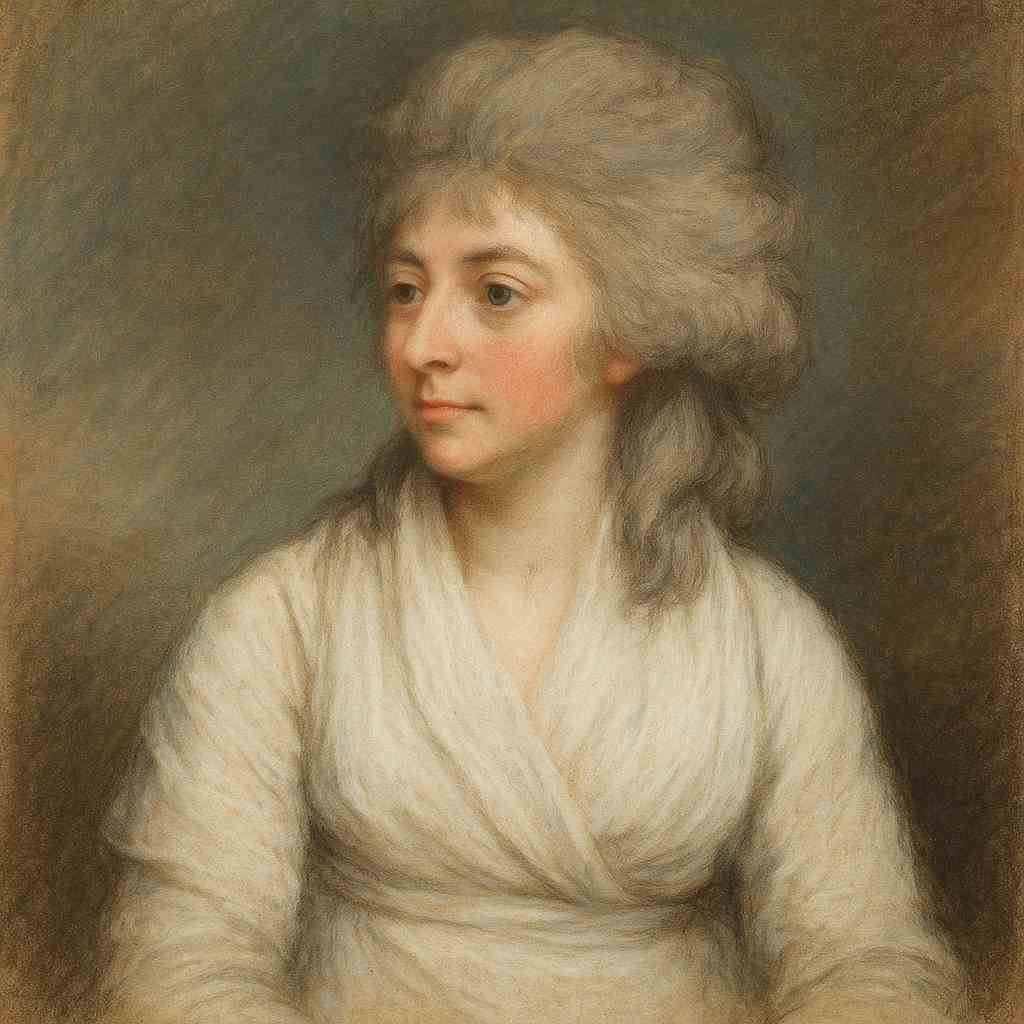Oh, Hope! thou soother sweet of human woes
Charlotte Smith
1749 to 1806

Oh, Hope! thou soother sweet of human woes!
How shall I lure thee to my haunts forlorn!
For me wilt thou renew the withered rose,
And clear my painful path of pointed thorn?
Ah come, sweet nymph! in smiles and softness drest,
Like the young hours that lead the tender year
Enchantress come! and charm my cares to rest:
Alas! the flatterer flies, and will not hear!
A prey to fear, anxiety, and pain,
Must I a sad existence still deplore?
Lo! the flowers fade, but all the thorns remain,
‘For me the vernal garland blooms no more.’
Come then, ‘pale Misery’s love!’ be thou my cure,
And I will bless thee, who though slow art sure.
Charlotte Smith's Oh, Hope! thou soother sweet of human woes
Introduction
Charlotte Smith's sonnet "Oh, Hope! thou soother sweet of human woes" presents a poignant exploration of the human psyche's relationship with hope in the face of despair. This work, penned during the Romantic era, exemplifies the period's preoccupation with emotional turbulence and the individual's struggle against the vicissitudes of life. Smith, a pioneering figure in the development of the English sonnet, crafts a deeply personal yet universally resonant piece that merits close examination for its thematic complexity, stylistic innovation, and emotional depth.
Historical and Literary Context
To fully appreciate the nuances of Smith's sonnet, one must first consider its historical and literary context. Composed in the late 18th century, this work emerges from a period of significant social and political upheaval. The French Revolution had sent shockwaves through Europe, challenging established norms and inspiring both hope and fear in equal measure. Simultaneously, the Romantic movement was gaining momentum, emphasizing individual experience, emotional intensity, and a return to nature as a source of solace and inspiration.
Smith, who lived from 1749 to 1806, was at the forefront of this literary revolution. Her personal life, marked by financial hardship, marital strife, and persistent ill health, profoundly influenced her writing. This biographical context lends additional poignancy to the poem's exploration of hope and despair, as we can infer that Smith was drawing from her own experiences of suffering and resilience.
Structural Analysis
The poem adheres to the Shakespearean sonnet form, consisting of three quatrains and a concluding couplet, with the rhyme scheme ABAB CDCD EFEF GG. This structure allows Smith to develop her theme in a logical progression, moving from an initial invocation of hope to a final, ambiguous embrace of misery. The volta, or turn, occurs in the ninth line, marking a shift from the hopeful apostrophe of the opening to a more resigned contemplation of suffering.
Smith's mastery of the form is evident in her skillful use of enjambment and caesura, which create a tension between the rigid structure of the sonnet and the fluid, almost conversational tone of the speaker. This tension mirrors the thematic conflict between hope and despair that lies at the heart of the poem.
Thematic Exploration
The central theme of the sonnet is the elusive nature of hope and its complex relationship with human suffering. Smith personifies Hope as a "sweet soother" and a "nymph," imbuing it with both comforting and alluring qualities. The speaker's desperate plea for hope to "renew the withered rose" and "clear my painful path of pointed thorn" vividly illustrates the restorative power attributed to this emotion.
However, the poem quickly subverts this idealized vision of hope. The nymph is revealed to be a "flatterer" who "flies, and will not hear," highlighting the ephemeral and unreliable nature of hope. This transition from eager invocation to bitter disappointment reflects a deeply pessimistic worldview, possibly influenced by Smith's own experiences of persistent hardship.
The imagery of roses and thorns, a classic motif in Romantic poetry, is employed to powerful effect. The fading flowers and remaining thorns serve as a metaphor for the transient nature of joy and the persistence of suffering. This imagery is particularly poignant in the line "For me the vernal garland blooms no more," which suggests a loss of innocence and the speaker's exclusion from the natural cycles of renewal and rebirth.
Language and Imagery
Smith's use of language is characterized by its emotional intensity and vivid sensory imagery. The opening apostrophe, "Oh, Hope!" immediately establishes an intimate, almost desperate tone that persists throughout the poem. The use of exclamation marks and question marks further emphasizes the speaker's emotional turmoil and sense of urgency.
The personification of abstract concepts is a key feature of Smith's poetic technique. Hope is variously described as a "soother," a "nymph," and an "enchantress," while Misery is personified as a lover in the final couplet. This anthropomorphization of emotions creates a sense of dialogue between the speaker and her internal states, highlighting the psychological complexity of the human experience.
The poem's imagery is rich in contrasts, juxtaposing the softness and beauty associated with hope (smiles, softness, young hours) with the harshness of reality (withered rose, pointed thorn, pain). This contrast is most starkly presented in the line "Lo! the flowers fade, but all the thorns remain," which encapsulates the poem's central theme of enduring suffering in the face of fleeting joy.
Psychological Depth
One of the most striking aspects of Smith's sonnet is its psychological acuity. The poem presents a nuanced exploration of the human mind's relationship with hope and despair, capturing the oscillation between these two states with remarkable precision. The speaker's initial eagerness to embrace hope, followed by the bitter acknowledgment of its unreliability, mirrors the cognitive patterns often observed in individuals grappling with depression or chronic adversity.
The final couplet, with its ambiguous embrace of "pale Misery," can be read as a commentary on the psychological mechanisms of coping with persistent suffering. The speaker's willingness to "bless" Misery because it is "slow" but "sure" suggests a kind of resignation that paradoxically offers its own form of comfort. This complex emotional state, where one finds solace in the very thing that causes pain, demonstrates Smith's profound understanding of the human psyche.
Feminist Interpretation
While not overtly feminist in its themes, Smith's sonnet can be read through a feminist lens, particularly when considered in the context of her life and times. As a woman writer in the 18th century, Smith faced numerous obstacles in both her personal and professional life. The poem's exploration of disillusionment and the struggle to maintain hope in the face of adversity can be seen as a reflection of the challenges faced by women in a patriarchal society.
The personification of Hope as a female "nymph" and the speaker's identification with this figure create a sense of feminine solidarity. However, the ultimate failure of Hope to provide lasting comfort could be interpreted as a critique of societal expectations placed on women to remain optimistic and nurturing even in the face of personal suffering.
Conclusion
Charlotte Smith's "Oh, Hope! thou soother sweet of human woes" stands as a testament to the enduring power of poetry to articulate the complexities of human emotion. Through its masterful use of form, vivid imagery, and psychological insight, the sonnet offers a profound meditation on the nature of hope and suffering. Smith's ability to capture the tension between desire and disappointment, between the allure of hope and the reality of persistent pain, speaks to the universal human experience of grappling with adversity.
The poem's final, ambiguous embrace of misery as a "sure" if "slow" comfort raises provocative questions about the nature of resilience and the human capacity to find meaning in suffering. In this sense, Smith's work transcends its historical context, offering insights that remain relevant to contemporary discussions of mental health, resilience, and the human condition.
As we continue to grapple with the complexities of hope and despair in our own lives, Smith's sonnet serves as a poignant reminder of the power of art to articulate our deepest emotions and provide a framework for understanding our place in a often chaotic and unpredictable world. It is a work that rewards repeated reading and reflection, offering new insights with each encounter and cementing Smith's place as a significant voice in the canon of English literature.
This text was generated by AI and is for reference only. Learn more
Want to join the discussion? Reopen or create a unique username to comment. No personal details required!



Comments
No comments yet. Be the first to comment!